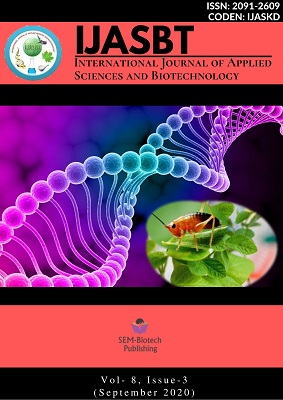Mustard Aphid and Crop Production
DOI:
https://doi.org/10.3126/ijasbt.v8i3.31558Keywords:
mustard aphid, Lipaphis erysimi, biology, management, infestationAbstract
Mustard aphid, Lipaphis erysimi (L.) Kaltenbach (Homoptera: Aphididae) is the most notorious, cosmopolitan louse-like and obligate ectoparasite, which causes a bulk of the qualitative and quantitative loss of rapeseed-mustard crops. This article reviews the general overview of biology, damages, and the management of mustard aphids. Biologically, L. erysimi adults are soft bodies, varying in color mostly yellowish-greenish, small to medium-sized, globular, pear-shaped, manifesting wing dimorphism based on the resource availability. Plasticity in reproductive mode either sexually or asexually stimulated as an adaptive response to cope with seasonal fluctuations, maximizes the chance of survival from predators being outnumbering. Mustard aphid infested host plant in three major ways, firstly by sucking the plant phloem through stylets, the needle-like piercing-sucking mouthparts which manifest injury like curling and yellowing of the leaf, stunting and drying up of the plants. Secondly, by excreting a sticky substance (honeydew) on which 'sooty mold' growth, which blocks the process of photosynthesis. Thirdly, it causes secondary plant injury by transmission and dissemination of viruses including turnip mosaic viruses. The appearance, multiplication, and disappearance of mustard aphid are largely regulated by weather variations. Its prolific multiplication greatly thrives by cool, wet, and cloudy weather. The mustard aphid can be eschewed more so if the crop is sown before 20th October. Applications of the recommended dose of fertilizers, irrigation, resistant varieties are some cultural practices to cope with the aphid population. Natural enemies are effective and impressive nowadays for crop protection. Ladybird beetles viz., Cocciniella septempunctata, Hippodamia variegata, and Cheilomones vicina are active predators of this pest. Chemical control includes the application of systemic insecticides below the ETL (Economic Threshold Level). Some major insecticide includes are Imidacloprid 17.8% @ 0.25 ml/l, Thiamethoxam 25 WG @ 0.2g/l and Dimethoate 30EC @ 1 ml/l of water.
Int. J. Appl. Sci. Biotechnol. Vol 8(3): 310-317




